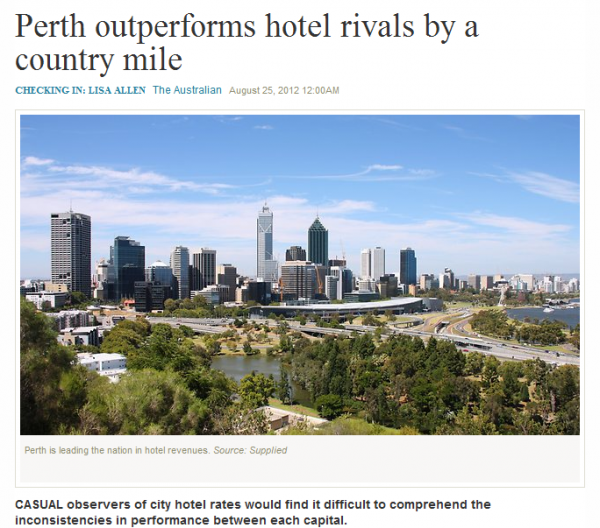Checking In: The Australian, 25 August 2012
?
Casual observers of city hotel rates would find it difficult to comprehend the inconsistencies in performance between each capital.
While Perth recorded an unprecedented 17 per cent growth in hotel revenue per available room last year, Sydney achieved just 7.2 per cent and Melbourne a paltry 3.3 per cent.
Adelaide and Gold Coast hotel revpar (the standard industry measure of profitability) fell marginally. Perth?s performance is ?unprecedented?, Rutger Smits, owner of AHS Advisory, a specialist in hospitality real estate and consulting, said.
?It?s astounding Perth is achieving these figures and all the other cities are not. Perth?s performance is not just a little bit bigger, it is double what Sydney and Melbourne are achieving.?
Mr Smits reckons Perth?s hotel managers should be transferred to Sydney and Melbourne ?to teach their colleagues there how to keep their cool and continue rate growth during ?adverse? market conditions?.
He is concerned Sydney and Melbourne hotel managers panic if bookings are not solid one week out and turn to heavy discounting to attract guests, thereby contributing to average room rate decreases. Perth hoteliers do experience volatility: while their hotels are full Monday to Thursday, the leisure market often does not kick-in over the weekends, leaving them with low occupancies. Sydney is the largest hotel market and the most volatile, according to Mr Smits? Hotel Performance Outlook.
But ?of the four largest city markets Sydney is again displaying the lowest room rate growth, despite the record occupancy performance?. Further south, Melbourne?s room rate growth has been at a complete standstill since last year principally because the Melbourne CBD absorbed more than 2000 new hotel rooms between 2005-10.
For Brisbane, the problem is new hotel supply is being added in waves, which is ?leading to temporary occupancy drops which are likely to trigger rate discounting strategies from hoteliers?.
Mr Smits said it was not the amount of new hotel room supply in Brisbane that was his biggest concern but rather the timing of it. He expects Brisbane?s revpar growth to continue at about 8 per cent until late next year before dropping to negative 2 per cent in 2014. Adelaide is of concern because new projects continue to be announced even though the South Australian capital?s hotel market is performing well below those of other capital cities.
Little or no rate growth is expected in 2014 because of an additional four hotels delivering 700 new rooms.
Canberra is difficult to predict because demand fluctuates, given its reliance on government and corporate activity. Canberra?s hotel supply has declined over the past five years resulting in room rate and occupancy growth.
?The outlook for the Canberra hotel market is for softer demand levels during 2012-14. Revpar will decline next year before returning to modest growth from 2014 and picking up from 2015.?
The rapid growth in Darwin hotel rates is producing average room-rate growth of 4 to 5 per cent. The Gold Coast sustained significant setbacks lasting well after the global financial crisis because international and domestic visits softened. ?Room occupancies should slowly return to the high 60 per cent as market demand continues to strengthen.?
As for north Queensland, it has gone through the deepest trough, with average annual room occupancy dropping as low as 55 per cent. Mr Smits believes room rates should return to growth when occupancy passes 60 per cent.


